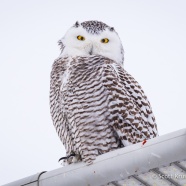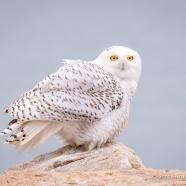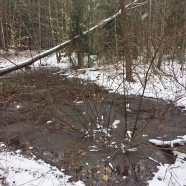Dark Snowy Owl
Today’s Snowy Owl was photographed in light snow and appropriately dark, arctic conditions. This heavily marked bird was a target of mine as the presumed juvenile female had been in the area for about a week. Do you notice anything else in the photos? You can see some bloody spots on the light from a recent meal. I only watched the bird for a few minutes as this was not a good place to linger, but others had reported seeing it eating rats in recent days. When I left the owl was still sitting there while countless drivers passed not knowing this special creature was right over their...
Read MoreSnowy Owl Take Two
Snowy Owl, take two! Here are photos from today after spending some time with what seemed to be the same owl as Sunday’s bird. The irruption is building as there are now four of them in and around Stratford, Connecticut. Let us hope some decide to stick around all winter long (Snowy in snow, please). I included a wider photo taken at 500mm because I wanted to show everyone concerned about giving them space what happens with my shots. I was at the same distance from the owl, the precise position, in all of the beach photos. I crop quite a bit to get the “close” shots. Every...
Read MoreSnowy Owl Arrival
Last week I posted a photo of a Merlin that I took after missing my first Snowy Owl of the season by a few minutes, lamenting my luck. I was hopeful I would be able to pick one up again soon considering the major Snowy flight south that is occurring now. Thankfully today I spent a few hours capturing the beauty of this bird! For the most part this time was filled with chatting with friends while observing it snoozing away. A few times the very calm bird (planes, diving gulls, unintentionally close beachgoers – no problem) did a bit of preening, and most of the eyes open shots came...
Read MoreWinter’s Not Over Yet
The fresh blanket of snow across the Western New York landscape is a good reminder that winter isn’t over just yet. However, some of our resident amphibians have been receiving crossed signals due to recent increases in daylight hours and above average temperatures; we have actually gotten reports of salamanders and frogs moving to nearby ponds and vernal pools to lay their eggs. With this weekend’s dropping temperatures, local pools have started to ice over indicating freezing temperatures near the surface. The eggs of some amphibian species are able to cope with fluctuating spring...
Read MoreFrost Free Frogs?
“The animal kingdom relies on staggering evolutionary innovations to survive winter.” Bernd Heinrich renowned biologist and author – made this statement in his bestselling book entitled “Winter World”. The Wood Frog (Rana sylvatica) is a true embodiment of this statement; these tiny amphibians can survive for weeks with an incredible two-thirds of their body water completely frozen—to the point where they are essentially solid frogsicles! The adaptation that enables this remarkable feat is known as a cryoprotectant – a substance that prevents damage to cells and tissues during...
Read More








